

5 Essential Components of Effective Customer Journey Maps. By Kathleen Hoski and Phil Goddard Journey maps are emerging as a key tool for managing enterprise customer and user experience programs.
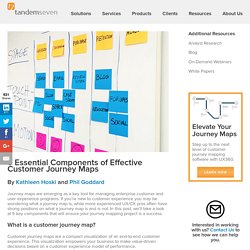
If you’re new to customer experience you may be wondering what a journey map is, while more experienced UX/CX pros often have strong positions on what a journey map is and is not. In this post, we’ll take a look at 5 key components that will ensure your journey mapping project is a success. What is a customer journey map? Customer journey maps are a compact visualization of an end-to-end customer experience. Common questions about journey maps include: Are customer journey maps strategic or tactical? Customer journey maps can be any of these as long as they include certain essential components. 5 Key attributes of effective customer journey maps 1. In contrast, a journey map that is built from a customer’s point of view will use the customer’s experience as the foundation of the journey map. An example of a journey map based on a customer’s perspective. Digital Disruption by Chris Thelwell. This is the third of a series of articles about how the design team operates at Envato.

In the first part I discussed the tools we use like Sketch and InVision. In the second part I explored how we structure the UX and product design practice. In this part I will focus on research, how we get to know our users and put them at the heart of our day-to-day work. UXPressia – Free customer journey mapping (CJM) templates, service blueprint and customer experience map examples. Who is On the Ideal Design Thinking Team? Part I - SAP User Experience Community.
While most of us already know what “T-shaped” means, it is disputed if “T-shaped people” really make the best design thinking team members.
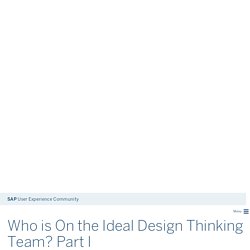
And what about all of those who aren’t “T-shaped”? This scenario might be familiar. You find yourself constantly confronted with the latest recruiting and design thinking buzzwords. They’ve have been flying around in your office, but you are not exactly sure what they actually mean. Sometimes you might even leave meetings scratching your head and asking yourself rather strange questions like, “I have been working out 3 times a week for several months now, am I “T-shaped” yet?”
Design Thinking: The Ideal Design Space. When you plan a design thinking session, choosing the right location can have a significant impact on the outcome.
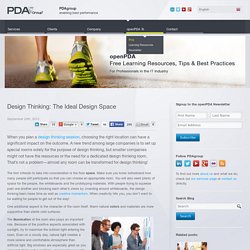
A new trend among large companies is to set up special rooms solely for the purpose of design thinking, but smaller companies might not have the resources or the need for a dedicated design thinking room. That’s not a problem—almost any room can be transformed for design thinking! The first criterion to take into consideration is the floor space. Make sure you know beforehand how many people will participate so that you can choose an appropriate room.
You will also need plenty of space for the people, the whiteboards and the prototyping materials. Creative Expedition at Auchan, with Jean-Yves Maurel. Jean-Yves Maurel is Corporate Innovation Director at Auchan Group, with the particularity of owning a double degree : Engineer Arts et Métiers ENSAM, and Marketing & Product Design at ENSAD.

He tells us about the amazing Creative Expedition process that has been going on for some time now at Auchan. Context and objectives Creative Expedition process is part of Auchan’s participative innovation plan called Creative Attitude, which has been rolled out over 4 countries, France, Spain, Italy, and Portugal, and covers 4 lines of business: ‘Hypermarket’ and ‘Superstore’ for retail, Banking, and Real Estate (related to shopping centres). Thus, Auchan Group wishes to “strengthen the means for capturing new markets, inventing new services, developing new channels, new ways of selling… and news ways of working within the company”. Creative Attitude collects ideas, filters them, and match idea’s owners with sponsors. Implementation is one of the key points for participative innovation. New Report Explores Design Thinking in Financial Services.
Design thinking is a methodology used during the process of designing and a problem-solving protocol which consists in, first, defining the problem, and then, implementing the solutions, always with the needs of the user demographic at the core of concept development.

User centric: design to solve an issue Design thinking is essentially about understanding the challenges that face customers and working with, observing and iterating with them to find a solution. It is also about taking a ‘human experience first’ approach to problem solving, and a customer-centered approach to end-to-end process fulfillment. In a new report released last week, Lightbulb Capital unveiled results of a survey it conducted on 24 experts in design thinking in financial services to learn about their experiences with design thinking in the financial sector. Respondents included chef innovation officers, senior UX consultants and other seniors in the innovation and design in banking sector. Design Thinking - The Bankers' View. Le Guide complet du Design Thinking.
What companies are similar to IDEO? - Quora. 5 MORE Must Read Books On Design Thinking — Peer Insight. 6.
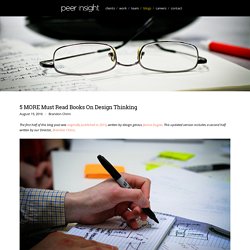
Design to Grow: How Coca-Cola Learned to Combine Scale & Agility (and How You Can Too) by David Butler and Linda Tischler, (Simon & Schuster, February 10) As design thinkers, you’ll want to always stay agile and customer centric, but once you have a solution that works, you need to start thinking about scaling it. Understanding Organizational Stakeholders for Design Success. Who stakeholders are and why they matter Stakeholders are defined as “individuals or organizations who stand to gain or lose from the success or failure of a system” (“Nuseibeh and Easterbrook, 2000”: For a software system, this can include managers, designers, and users of a system.

Since, by definition, stakeholders are those who are impacted by (or have an impact on) the project, their perspectives need to be taken into account in order for a project to be successful. Stakeholders can have positive or negative views regarding a given project, and often don’t agree with one another, making it a challenge to reconcile their varied viewpoints. A design must meet the business needs of the company, and must be supported by disparate members of the management team, in order to be actually implemented.
Vers la mort du Design Thinking ? - Les cahiers de l'innovation. Quand j’ai cherché ce qu’était le « design thinking » la première fois, je suis tombé sur cette définition : le design thinking permet de réaliser des produits ou des services « désirables par le consommateur, même s’il n’aurait jamais exprimé clairement un tel vœu, réalisables techniquement et viables économiquement », résume Véronique Hillen, aujourd’hui doyenne de la Paris-Est d.school à l’École des ponts .

Le design thinking est « un mode d’application des outils de conception utilisés par les designers pour résoudre une problématique d’innovation, par une approche multidisciplinaire centrée sur l’humain ». Si certains annoncent déjà la mort du design thinking, ses méthodologies se retrouvent aujourd’hui disséminés dans toutes les situations où quelque chose est conçu (nouveau produit ou service). Les projets que je soutiens dans le cadre professionnel ont de plus en plus cette approche (je pense à 3pod par exemple). Design de Services et Innovation – Sylvie Dalmau / Suzanne Kan – Formation CNAM Gestion projet 2.0. Souvenez-vous, le 22 novembre dernier, Fabienne Schouler a réussi à s’échapper quelques heures de sa fonction de Design Lead au Technocentre Orange Labs pour venir nous parler de sa vision du Design de Service.
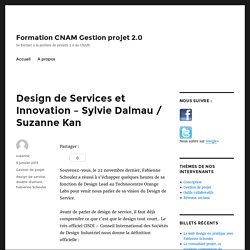
Avant de parler de design de service, il faut déjà comprendre ce que c’est que le design tout court.. Le très officiel CISDI – Conseil International des Sociétés de Design Industriel nous donne la définition officielle : » Le design est une activité créatrice qui consiste à déterminer les propriétés formelles des objets que l’on veut produire industriellement » Le designer n’est pas un artiste, mais celui qui va rendre un objet à la fois Utile, Utilisable, et Désirable. C’est en se basant sur ces 3 piliers que le designer va permettre à l’utilisateur d’un service de fluidifier son parcours de sauts d’obstacles lors de l’utilisation d’un service : c’est « l’organisation des informations et des situations afin d’en augmenter l’efficacité, la perception et la qualité ». 1. 2. Design Thinking & Strategy - Good Kitchen Case Study. Lockwood Resource. Discovering the real problems Design thinking is a human-centered innovation process that emphasizes observation, collaboration, fast learning, visualization, and rough prototyping.
The objective is to solve not only the stated problem at hand, but the real problems behind the obvious. The best way to do so is to involve consumers, designers, researchers, and businesspeople in an integrative process, which can be applied to product, service, or even business design. It is also a tool to imagine future states and to bring products, services, and experiences to market. The term design thinking is generally referred to as applying a designer’s sensibility and methods to problem solving, no matter what the problem is. Design Thinking Is A Failed Experiment. So What's Next?
The decade of Design Thinking is ending and I, for one, am moving on to another conceptual framework: Creative Intelligence, or CQ. I am writing a book about Creative Intelligence, due out from HarperCollins in fall 2012, and I hope to have a conversation with the Fast Company audience on this blog about how we should teach, measure, and use CQ.
Why am I, who at Business Week was one of Design Thinking's major advocates, moving on to a new conceptual framework? Simple. Design Thinking has given the design profession and society at large all the benefits it has to offer and is beginning to ossify and actually do harm. Helen Walters, my wonderful colleague at Business Week, lays out many of the pros and cons of Design Thinking in her post on her blog. Vers la mort du Design Thinking ? - Les cahiers de l'innovation. L'esprit design, Le design thinking change l'entreprise et la stratégie. Tom Kelley & David Kelley. The core argument of Creative Confidence is simple: Everyone can be creative. Those who see themselves as non-creative might bristle at the notion.
But David Kelley and Tom Kelley make a compelling case that creativity is innate in human beings — all human beings. Personas Make Users Memorable for Product Team Members. The field of user experience centers on the idea that we must design products around people, rather than teaching people how to use products: user-centered design (UCD), not technology-centered design. In order to do so, we must understand people—their behaviors, attitudes, needs, and goals.
Whether the final product is a website, software application, mobile app, or interactive kiosk, a user-centered design can only be achieved if we know who is going to use it and if that knowledge informs our design. Dthinking. Welcome to the Virtual Crash Course in Design Thinking. Welcome to the d.school’s Virtual Crash Course resource page! We know not everyone can make a trip to the d.school to experience how we teach design thinking. So, we created this online version of one of our most frequently sought after learning tools. Using the video, handouts, and facilitation tips below, we will take you step by step through the process of hosting or participating in a 90 minute design challenge. If you choose to participate, in 90 minutes you will be taken through a full design cycle by participating in The Gift-Giving Project. This is a fast-paced project where participants pair up to interview each other, identify real needs, and develop a solution to “redesign the gift-giving experience” for their partner.
Through this experience we hope you will take away some of the basic principles of Design Thinking and start to adapt them into your personal and professional routines. Below, you will find three sections: Gear Up! Products of Design Thinking - Multimedia Feature. 18 Thoughts About Design Thinking Corporate Rea... Yesterday I had the pleasure to do a Pecka Kucha session during the Entwicklertag Frankfurt. The session was in German and it was about 18 thoughts about design thinking corporate reality (from a personal point of view).
Here is a summary: 1) The real challenge with design thinking for me is not the intellectual understanding of the concepts, tools and methods but in the consequent and sustainable integration and active usage during the daily job. 2) The creative, trustful, open and experimental team atmosphere, we would like to establish within a design thinking team, is nothing which will happen by its own but you have to invest into this by doing regular and moderated daily standups, team retrospectives and feedback cycles. Especially personal feedback between team members is helpful here, and in my experience it seems to be easier for most people to give only positive feedback. Design & Thinking - a documentary on design thinking.
Les étapes du Design Thinking. Le Design Thinking, une démarche de conception qui entre dans le monde de l'entreprise - Digital Corner. Roger Martin - Rotman School Toronto. Theories & Methods « Systemic Design. Theories and Methods of Systemic Design Back to RSD3 proceedings overview Peter Jones. Design Methods for Systemic Design Research. Why Mood Boards Matter. Design studies forum › Rethinking Design Thinking: Part I. Rethinking Design Thinking. Posted by Don Norman | 19 Mar 2013 | Comments (15) [Dossier] Qu'est-ce que le design thinking ? On pourrait penser que c’est une mode, mais le design thinking est bel et bien né dans années 1950.
De San Francisco à Delhi, en passant par Londres et Berlin, cette méthode qui oblige à repenser les cycles de création et de management en entreprise par le design convainc les plus réfractaires. Trois écoles spécialisées ont déjà ouvert. [Dossier] Qu’est-ce que le design thinking ? Creative Intelligence or Design Thinking? Veille Design Thinking. Design Thinking: Dear Don . . . Rethinking Design Thinking. Introduction to Design Thinking. [Dossier] Qu'est-ce que le design thinking ? Excerpt: Design Thinking for Strategic Innovation. Design Thinking for Social Innovation. Design Thinking for Startups - Are You Design Driven?
Design thinking positioned company. Strategic Innovation. Design et stratégies d'innovation. Helixa - Innovation / Strategy / Design - EN. Thomas Villeneuve: Le Design Thinking, pour innover au-delà de la technologie! Design thinking schools. Pourquoi Kalachnikov a-t-il connu un tel succès. Case Study: Outlier on Creating the 21st Century Jean. Le "design thinking" à la conquête de l'Hexagone. Meet Google Drive – One place for all your files.